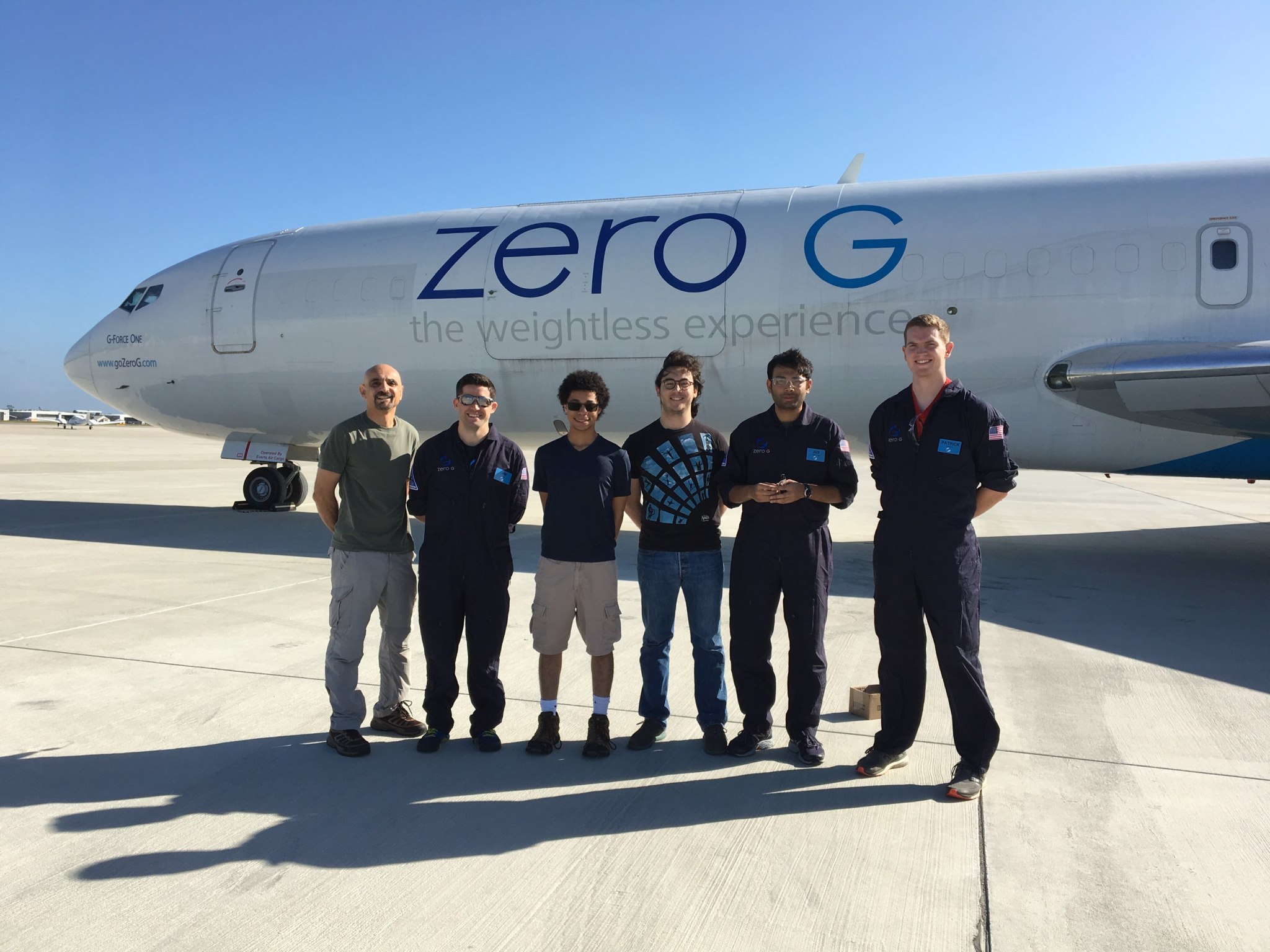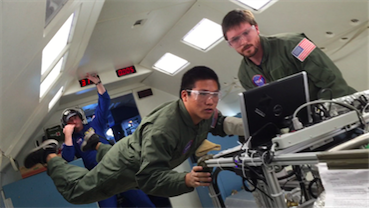Zero Gravity Corporation (ZERO-G) completed a series of parabolic flights, testing payloads from academic and commercial organizations in November 2017. The technologies ranged from proposed new space suits to cryogenic propellant research, with implications for future NASA space missions as well as other research efforts.
These technologies were selected for flight testing as part of NASA’s Space Technology Research, Development, Demonstration, and Infusion (REDDI) solicitations, administered through NASA’s Flight Opportunities program. Recipients of SpaceTech-REDDI awards receive funds to purchase flights for demonstration from a suitable commercial flight provider.
Achieving 30 parabolas over each of four flights, ZERO-G’s modified aircraft, G-FORCE ONE, simulated a space-like environment, with periods of microgravity during each parabola. With some of the reduced gravity periods approximating conditions on the moon and others on Mars, researchers had the opportunity to test a variety of performance metrics for their experiments.
“With these flights, we have the flexibility to test a lot of different parameters very quickly, and we have the opportunity to reconfigure the experiment in real time,” said Dr. Amir Hirsa, principal investigator for an experiment from Rensselaer Polytechnic Institute in collaboration with Arizona State University.
As with previous flight campaigns with ZERO-G, researchers noted the value of having the parabolic flights spaced out over several days.
“The first day of flight was pretty choppy with a lot of turbulence. Those conditions may have actually revealed some unanticipated science. We’re analyzing our data now to evaluate this,” said Dr. Hirsa. “But the second day was smooth and exactly as planned. The difference revealed a weakness in the design, and we’ve already started communicating with the contractor who is building our hardware for an upcoming International Space Station experiment.”
Researchers also reiterated the enabling nature of technology demonstrations in a microgravity environment.
“You can’t predict this kind of stuff on a computer,” said Dr. Jungho Kim, principal investigator for an experiment from the University of Maryland. “And even if you could, you would still have to verify it. These flights have been critical to our research.”
For ZERO-G, the flight campaigns demonstrated the high quality of work being done by researchers selected by the Flight Opportunities program, especially on the collegiate level.
“The students who are flying with us have been of a very high caliber and their experiments and attitudes toward their research are every bit as committed as the other organizations that we’ve worked with,” said Michelle Peters, ZERO-G’S director of research and education and supervisor of inflight. “It’s exciting for us to see their work advance beyond their demonstrations with us, and even see some of them begin to approach orbital experiments. It brings it full circle.”
Terese Brewster, president of ZERO-G, noted that the ongoing relationship with NASA is good for space exploration-based research.
“I think NASA’s transition to contracting with commercial organizations is a really positive one,” said Brewster. “We see researchers coming back with payloads and perfecting them over multiple flights and really creating technologies that we think can help move the space program ahead quickly.”
Ron Young, program manager for Flight Opportunities agreed saying, “we are pleased to be fostering the industry in a way that is enabling broader utilization and growing the customer base to allow new participants to take advantage of these relevant environments.”
The experiments demonstrated on the recent flights were:
T0172-P: Development of a Revolutionary Approach for Efficient Microgravity Transfer Line Chilldown, University of Florida–Gainesville
This experiment addresses the tank-to-tank cryogenic propellant transfer needed in zero-gravity for manned missions to Mars. The research team tested the performance of a transfer pipe with a nanoparticle surface coating that attracts liquid cryogen toward the pipe wall to speed the chilldown process and minimize the cryogen loss. The system maintained integrity in microgravity and high g-forces during flight. Findings show that coating the transfer pipe reduced chilldown time and could decrease propellant consumption by as much as 50-60 percent in microgravity. The team is continuing its research to further advance the technology.
T0160-P: Microgravity Propellant Gauging Using Modal Analysis: Phase II, Carthage College
Traditional methods of propellant gauging suffer from decreasing accuracy as the tank empties. As a result, mass-gauging accuracy is lowest at the end of mission life, when it is most important. This flight captured the modal response of a propellant tank at different fill levels under unsettled, microgravity conditions as well as during simulated propellant transfer. The goal was to determine how to both mitigate and compensate for sloshing to improve gauging speed and accuracy. The technology is currently slated to fly on NASA’s Orion Exploration Mission-3.
T0170-P: Ground-Based Study of Flow Boiling Heat Transfer Effects in Preparation for an ISS Flight Experiment, University of Maryland
This experiment addresses researchers’ current inability to predict with sufficient confidence the performance of two-phase thermal systems for spacecraft. The team has been acquiring data and developing models to predict the behavior of two-phase flows relevant to advanced heat exchangers. Their flights with ZERO-G enabled them to collect data in microgravity as well as upward and downward flows in Earth, Lunar, and Martian gravities. The researchers are now analyzing data in preparation for a future ISS flight experiment. Data collected during these flights is needed for engineers to develop smaller, lighter weight space-based heat exchangers.
T0154-P: PRIME-4.0: Miniaturized and Reusable Asteroid Regolith Microgravity Experiment for Suborbital and Orbital Use, University of Central Florida
The Physics of Regolith Impacts in Microgravity Experiment (PRIME) was developed to provide experimental data on the behavior of asteroidal regolith (“soil”) in near-zero-gravity conditions. Future exploration missions to asteroids will require knowledge of how regolith might impact anchoring to the surface, sample collection, and other activities. The PRIME team’s flights with ZERO-G enabled them to study the response of simulated asteroidal regolith to very gentle disturbances in the gravitational environment of a small asteroid.
T0175-P: Testing of a Novel Intra-Vehicular Activity (IVA) Space Suit, Final Frontier Design
The IVA Space Suit prototype was developed to address the safety and comfort needs of astronauts and passengers working at extreme altitudes. Such missions require suits that enable them to survive a catastrophic failure of the cabin pressurization system. However, current suits are expensive, heavy, and restrict mobility. The IVA Space Suit is a single-layer, flat-pattern pressure suit that offers a cost-saving alternative. The flights with ZERO-G enabled researchers to test the performance of the suit in microgravity with four test subjects, analyzing a variety of pressure positions in the suit and testing the simulator and harness system.
T0183-P: Protein-Drop Pinning in Microgravity, Rensselaer Polytechnic Institute, NASA’s Marshall Space Flight Center, and NASA’s Glenn Research Center
The Ring-Sheared Drop (RSD) module technology has been developed to examine the effects of shear at hydrophobic interfaces on protein aggregation. Recently authorized to proceed to a mission to the ISS, the technology promises a more efficient way of mixing within liquids to produce pharmaceuticals and other organic materials needed for extended space missions. The parabolic flights with ZERO-G enabled the team to identify necessary hardware corrections and gather unexpected but highly relevant data about the impact of g-jitter on their experiment.
About NASA’s Flight Opportunities Program
Through the Flight Opportunities program, the Space Technology Mission Directorate (STMD) strives to advance technologies from industry, academia, and government by providing opportunities for testing and technology demonstration on commercial launch vehicles. The program is managed at NASA’s Armstrong Flight Research Center in Edwards, California. STMD is responsible for developing the crosscutting, pioneering new technologies and capabilities needed by the agency to achieve its current and future missions.
For more information about the Flight Opportunities program, visit:
https://www.nasa.gov/flightopportunities
Leslie Williams
NASA Armstrong Flight Research Center































